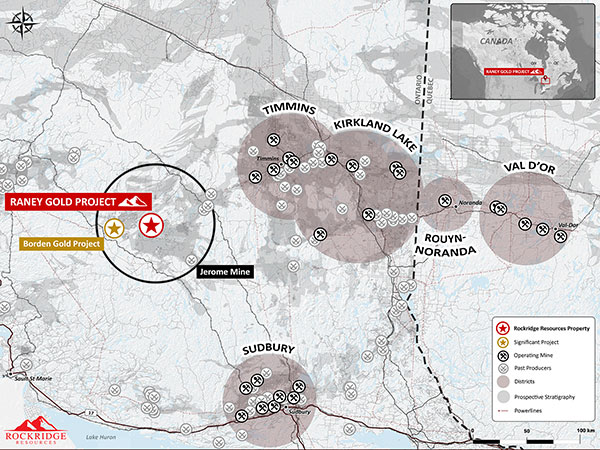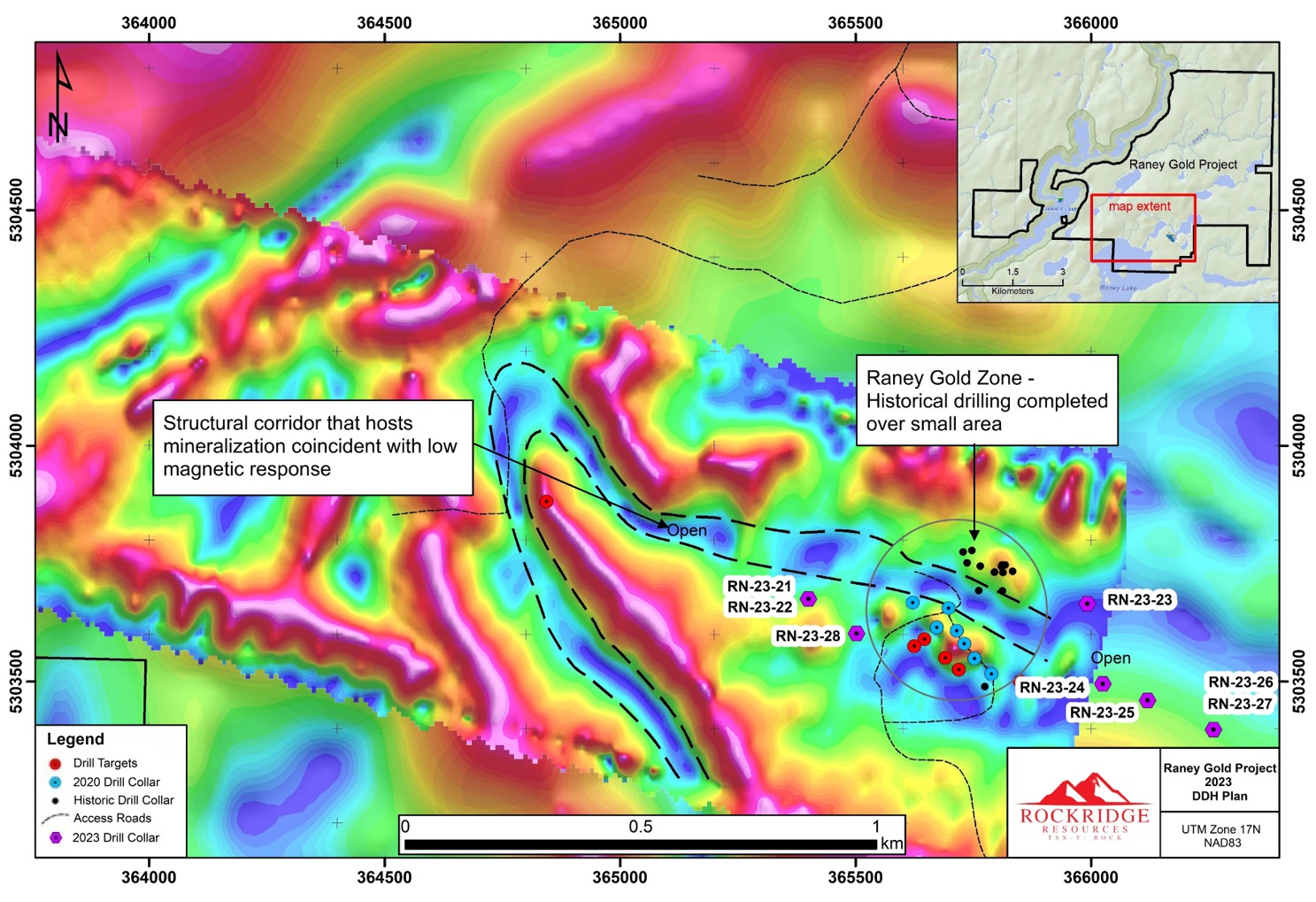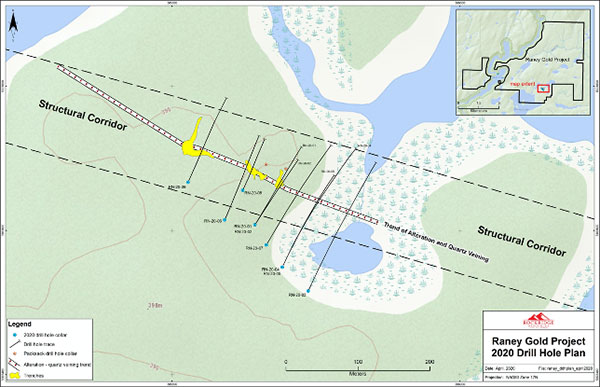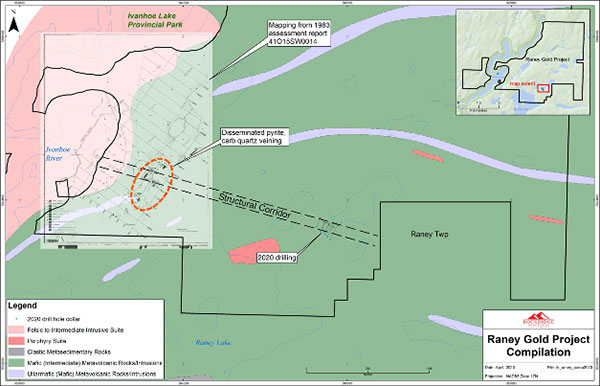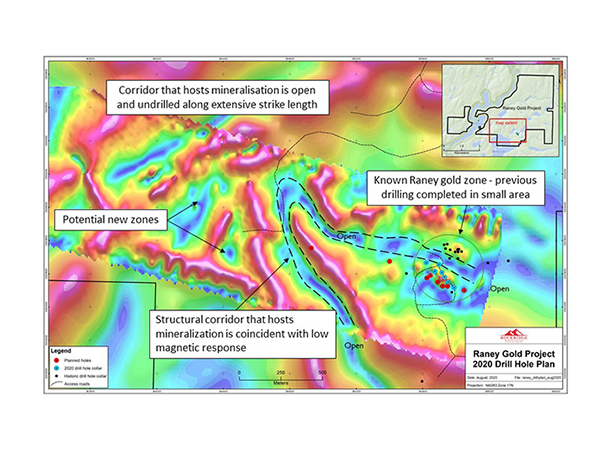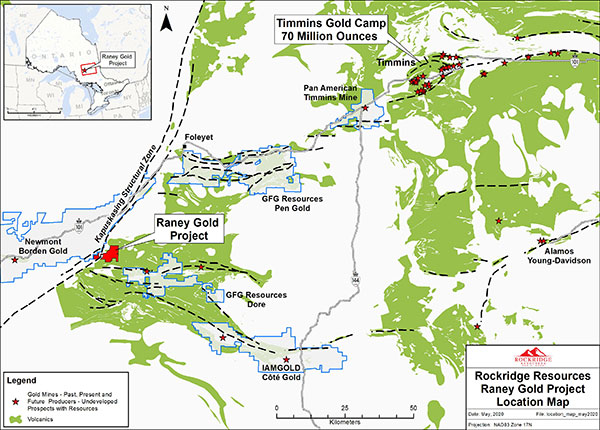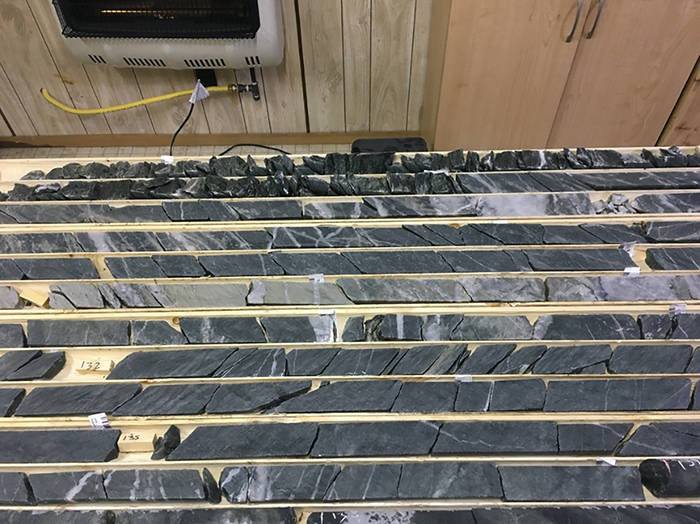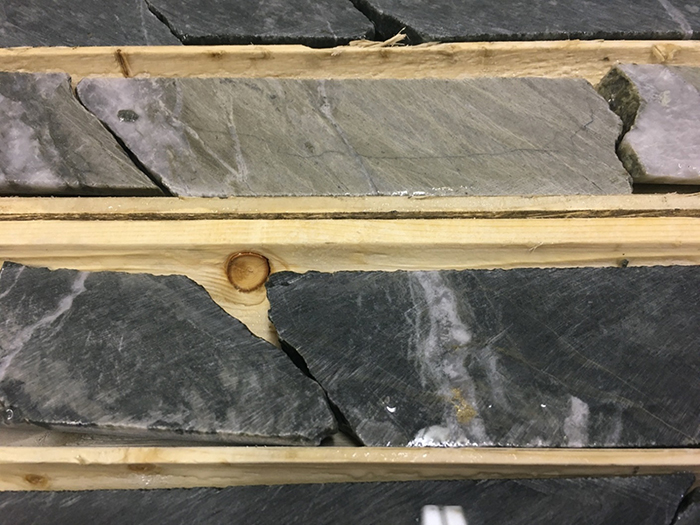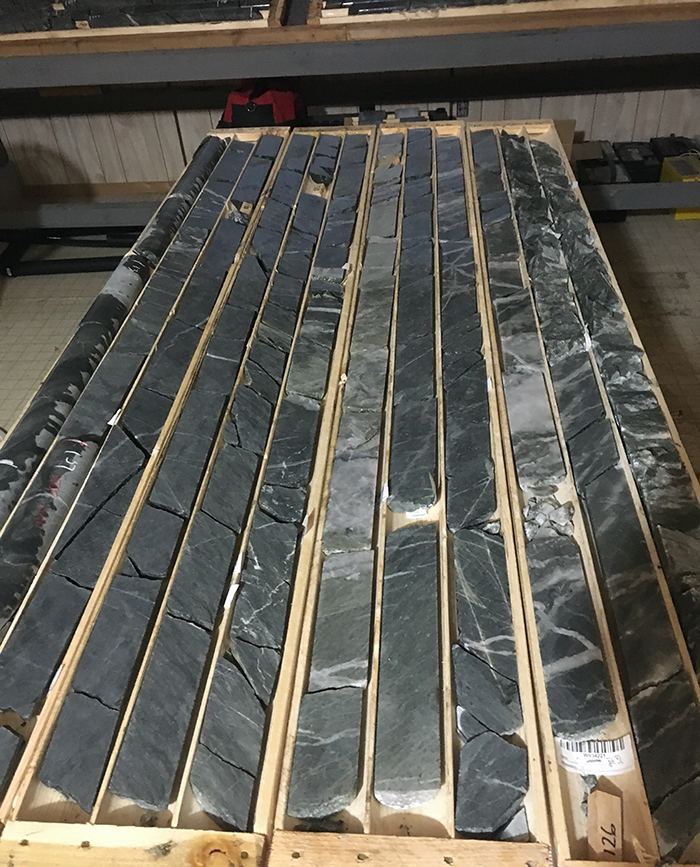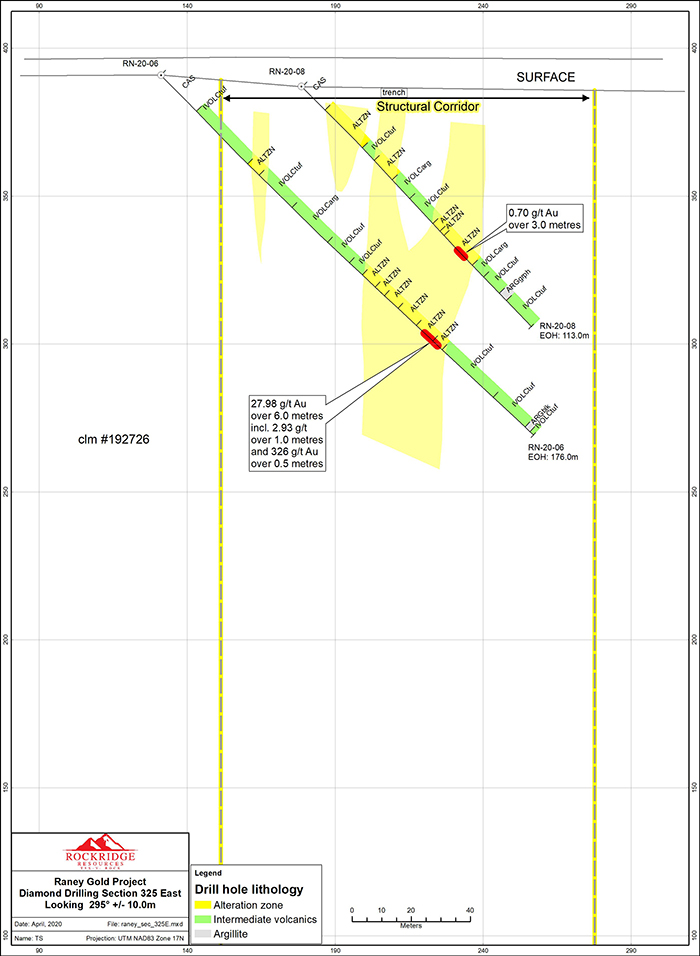Raney Gold Project
The Property is located in Ontario, 110 km southwest of the city of Timmins, and is accessible by highway and secondary roads.
Raney Property – Location
Highlights:
- Rockridge owns a 100% interest in the Raney Gold Project
- The Raney Gold Project is a large prospective gold property covering ~2,800 hectares located ~110 km southwest of the prolific gold district of Timmins, ON
- Project is in the Archean Swayze Greenstone Belt which is a part of the Abitibi Greenstone Belt which hosts the world class Timmins and Kirkland Lake lode gold mining camps
- Limited historical exploration campaigns conducted on the Property; the last exploration activities prior to the 2020 program occurred ~10 years ago when gold prices were in the US$900/oz. range
- Early 2020 exploration program followed-up on historical drill results (best historic intercept returned ~6.5 g/t gold over 8 metres, uncut)
- Early 2020 drilling program entailed 2,070 metres in nine diamond drill holes; highlight intercept in hole RN 20-06 of 28 g/t gold over 6 metres (uncut) at a shallow vertical level of 95 metres
- The program tested the mineralized gold system along a strike extent of 225 metres, with the deepest hole at the 260-metre level
- Gold mineralization is associated with broad intervals of higher concentrations of narrow quartz veins; the quartz veins are hosted in a steeply dipping alteration zone dominated by intermediate volcanic rocks consisting of lapilli tuffs and bedded argillites, with lamprophyre dikes
- The broad structural corridor that hosts the mineralization is open for expansion; historic mapping and surface sampling data show that it may extend over several hundred metres, with no drilling completed over a large extent of this corridor
- A notable disruption in the airborne magnetic data approximately 2 km west of the recent drilling and in line with the projected structural corridor provides a compelling target area for future exploration
- Winter 2020/2021 drilling program entailed 2,965 metres in eleven diamond drill holes to evaluate the down-plunge and strike extent of the Raney Gold Zone
- Property has excellent access and infrastructure; accessible by paved and forestry roads
- Newmont’s newest gold mine (Borden) is located ~35km west and IAMGOLD’s Cote development project is ~75km southeast
- Rockridge recently completed the 2023 drill program which consisted of 2,020m of drilling in 8 diamond drill holes
2023 Drill Program:
The 2023 drill program continued to expand the central Raney Gold Zone and tested the extension of the Raney Zone in the east and the west directions. Alteration associated with the gold mineralization is coincident with a distinct magnetic low signature. Notably, numerous holes including the step out holes intersected mineralization.
The 2023 Raney drill program has demonstrated the extension of the Raney zone to the northwest with the intersection of alteration and mineralization in holes RN-23-21 and RN-23-22. A newly discovered style of mineralization associated with a brittle structure intersected in RN-23-21 and RN-23-22 represents an important new target for follow up testing.
Follow up drilling was completed and aimed to fill gaps within areas of known mineralization and ultimately helped design a larger program to further evaluate the strike, depth and expansion potential of the high-grade zones of gold mineralization discovered from previous programs.
Diamond Drill Hole Summaries:
Hole RN-23-21 was collared approximately 250m west of the Raney main zone, testing the structural extension of the alteration system. The hole was a follow up to hole RN 20-18 which intersected 1.36 g/t Au over 9.0m from 141.0m to 150.0m; including 1.67 g/t Au over 7.0m from 141.0m to 148.0m and including 2.1 g/t Au over 4.0m from 141.0m to 145.0m.
Hole RN-23-21 intersected 1.5 g/t Au over 4.5m starting at 145.5m depth which is hosted in a brittle fault structure and represents a new exploration target. A second interval of 1.2 g/t Au over 2.5m starting at 160m depth was discovered in weakly altered material similar to the Raney Zone.
Hole RN-23-22, which was drilled from the same setup as RN-23-21 at a steeper angle, intersected multiple intervals of alteration and quartz veining which assayed 1.01 g/t Au over 7.5m starting at 177m including 4.02 g/t gold over 1.5m from 178m depth.
A second intersection of 2.4 g/t Au over 7.5m starting at 249m depth included 11.7 g/t Au over 1.0m from 251m, and is hosted within a similar brittle fault zone as intersected in hole RN-23-21. This represents a new exploration target for at Raney Project at depth.
Mag Survey Plan Map Showing Exploration Hole Collars:
Holes RN-23-23 and RN-23-24 were located northeast of the Raney zone testing a magnetic low feature that is coincident with the Raney zone. Hole RN-23-23 intersected numerous zones of alteration with quartz veining and an interval of 0.6 g/t Au over 3.5m starting at 46.5m depth.
Drill hole RN 23-28 intersected 0.87 g/t gold over 4m starting at 178m depth including 2.71 g/t gold over 1m, and 0.36 g/t gold over 7m at 229m. Additional gold mineralization was intersected in hole RN 23-28 including 0.19 g/t gold over 4.5m starting at 24.5m depth.
2020 Drill Program Summary:
A total of 2,070 metres in nine diamond drill holes were completed during the program to assess the potential of the Raney Gold Project (Table 1).
| DDH # | East (UTM) | North (UTM) | Elev | Az | Dip | Depth (m) |
| RN-20-01 | 365715 | 5303608 | 391 | 25 | -45 | 179 |
| RN-20-02 | 365715 | 5303608 | 391 | 25 | -65 | 276 |
| RN-20-03 | 365789 | 5303516 | 391 | 25 | -45 | 291 |
| RN-20-04 | 365753 | 5303549 | 391 | 25 | -45 | 306 |
| RN-20-05 | 365753 | 5303549 | 391 | 25 | -58 | 320 |
| RN-20-06 | 365673 | 5303615 | 391 | 25 | -45 | 176 |
| RN-20-07 | 365731 | 5303580 | 391 | 30 | -45 | 237 |
| RN-20-08 | 365698 | 5303656 | 387 | 25 | -45 | 113 |
| RN-20-09 | 365622 | 5303667 | 387 | 30 | -45 | 174 |
Detailed logging and sampling of the early 2020 drill program core has been completed. A summary of assay results are reported below:
- Hole RN 20-01 returned 0.83 g/t Au over 8.9 m from 126.1 m to 135 m
- Hole RN 20-02 returned 0.63 g/t Au over 8.5 m from 77.5 m to 86 m; and 1.39 g/t over 13 m from 102 m to 115 m, including 3.72 g/t over 3 m from 103 m to 106 m
- Hole RN 20-03 returned 0.52 g/t Au over 23 m from 239 m to 262 m
- Hole RN 20-04 - no significant assays
- Hole RN 20-05 returned 6.45 g/t Au over 1 m from 110 m to 111 m; and 1.28 g/t over 2 m from 295 m to 297 m
- Hole RN 20-06 returned 27.98 g/t Au over 6 m from 125 m to 131 m, including 2.93 g/t over 1 m from 125 m to 126 m, 71.28 g/t over 2.3 m from 128.7 m to 131 m, and 326 g/t over 0.5 m from 130.5 m to 131 m
- Hole RN 20-07 returned 0.62 g/t Au over 5.0 m from 35.0 m to 40.0 m; 0.69 g/t Au over 5.0 m from 89.0 m to 94.0 m; 0.57 g/t Au over 7 m from 112.0 m to 119.0 m, including 1.17 g/t Au over 3.0 m from 114.0 m to 117.0 m
- Hole RN 20-08 returned 0.39 g/t Au over 6.0 m from 12.0 m to 18.0 m; and 0.7 g/t Au over 3 m from 76.5 m to 79.5 m
- Hole RN 20-09 returned 0.42 g/t Au over 4.0 m from 51.0 m to 55.0 m; and 0.49 g/t Au over 2.0 m from 108.5 m to 110.5 m
True widths are not estimated at this time.
Raney Property – 2020 Drill Hole Location Map
The Spring 2020 drill program focused on the main zone over a strike extent of approximately 225 metres that produced the best historic intercept of 6.5 g/t gold over 8 metres. The deepest hole of the current program tested down to the 260-metre level.
Silicification and minor carbonate alteration were recognized, however gold mineralization appears to be closely related to intervals of high quartz vein density. The quartz veins are hosted in a steeply dipping alteration zone dominated by intermediate volcanic rocks consisting of lapilli tuffs and bedded argillites, with lamprophyre dikes. The quartz veins crosscut and run parallel to a weak fabric, and range in thickness from 0.5 cm to 20 cm in width.
A zone of increased vein density has been noted where the historic visible gold intercepts occur. The high-grade intercept of 28 g/t over 6 metres from the Spring 2020 program was the fourth drill hole on the Property to intercept visible gold, and all these occurrences were in the main zone near the 100-metre level.
The broad structural corridor that hosts the mineralization is up to 125 metres wide and extends well beyond the area tested by drilling. Historic mapping and surface sampling data show that the corridor may extend over several hundred metres. No drilling has been conducted along this corridor except for the ~225-metre-long main zone (Figure 3).
A notable disruption in the airborne magnetic data approximately 2 km west of the past drilling is being tested in the current drill program. The target is in line with the projected structural corridor identified by historical results.
Raney Property – 2020 Plan Map Showing Exploration Potential Along Structural Corridor
Raney Property – 2020 Plan Map Showing Exploration Potential Along Structural Corridor
Winter 2020/2021 Drill Program Summary:
A total of 2,965 metres in eleven diamond drill holes were completed during the program to evaluate the down-plunge and strike extent of the Raney Gold Zone.
| Drill | UTM | UTM | Elevation | Azimuth | Dip | Depth |
| Hole | East | North | (m) | (m) | ||
| RN-20-10 | 365644 | 5303587 | 397 | 25 | -45 | 210 |
| RN-20-11 | 365633 | 5303579 | 397 | 25 | -60 | 273 |
| RN-20-12 | 365633 | 5303579 | 397 | 25 | -52 | 240 |
| RN-20-13 | 365691 | 5303550 | 387 | 25 | -47 | 225 |
| RN-20-14 | 365691 | 5303550 | 387 | 25 | -67 | 336 |
| RN-20-15 | 365858 | 5303482 | 387 | 25 | -60 | 330 |
| RN-20-16 | 365850 | 5303500 | 387 | 30 | -60 | 481 |
| RN-20-17 | 365568 | 5303589 | 387 | 180 | -45 | 102 |
| RN-20-18 | 365400 | 5303675 | 387 | 0 | -45 | 252 |
| RN-20-19 | 364844 | 5303882 | 387 | 55 | -45 | 276 |
| RN-20-20 | 364844 | 5303882 | 387 | 245 | -45 | 240 |
A summary of assay results for nine holes are reported below:
- Hole RN 20-10 returned 1.37 g/t Au over 3.5m from 157m to 160.5m
- Hole RN 20-11 returned 2.18 g/t Au over 5.7m from 153.8m to 159.5m; and 2.68 g/t Au over 0.8m from 250.7m to 251.5m
- Hole RN 20-12 returned 1.38 g/t Au over 6.5m from 144.5m to 151.0m; and 1.27 g/t Au over 4.0m from 211.5m to 215.5m
- Hole RN 20-13 returned 2.5 g/t Au over 13.0m from 133.0m to 146.0m; including 3.41 g/t Au over 9.0m from 135.0m to 144.0m and including 9.6 g/t over 2.0m from 135.0m to 137.0m
- Hole RN 20-14 returned 1.97 g/t Au over 2.0m from 248.5m to 250.5m
- Hole RN 20-15 and hole RN 20-17 - no significant values
- Hole RN 20-16 returned 2.21 g/t Au over 1.0m from 387.0m to 388.0m
- Hole RN-20-17 was drilled to test the feldspar porphyry and a high-grade surface gold showing and intersected anomalous gold grades
- Hole RN 20-18 returned 1.36 g/t Au over 9.0m from 141.0m to 150.0m; including 1.67 g/t Au over 7.0m from 141.0m to 148.0m and including 2.1 g/t Au over 4.0m from 141.0m to 145.0m
- Holes RN-20-19 and RN-20-20 were large step outs approximately 1,000 metres west of the main Raney Gold Zone where no prior drilling had been conducted. Both holes did not return any significant gold values. True widths are not estimated at this time.
True widths are not estimated at this time.
The drill program was designed to evaluate a number of exploration ideas/concepts including testing the down plunge and depth continuity of high-grade gold mineralization intersected in previously drilled holes; testing the eastward and westward continuity of the Raney Gold Zone as suggested by a well-defined magnetic low signature along strike as identified from a drone survey; testing a relatively underexplored feldspar porphyry unit, and testing a newly identified magnetic signature along strike to the Raney Gold Zone that exhibited a distinct fold geometry.
2020 Exploration Program Core Photos:
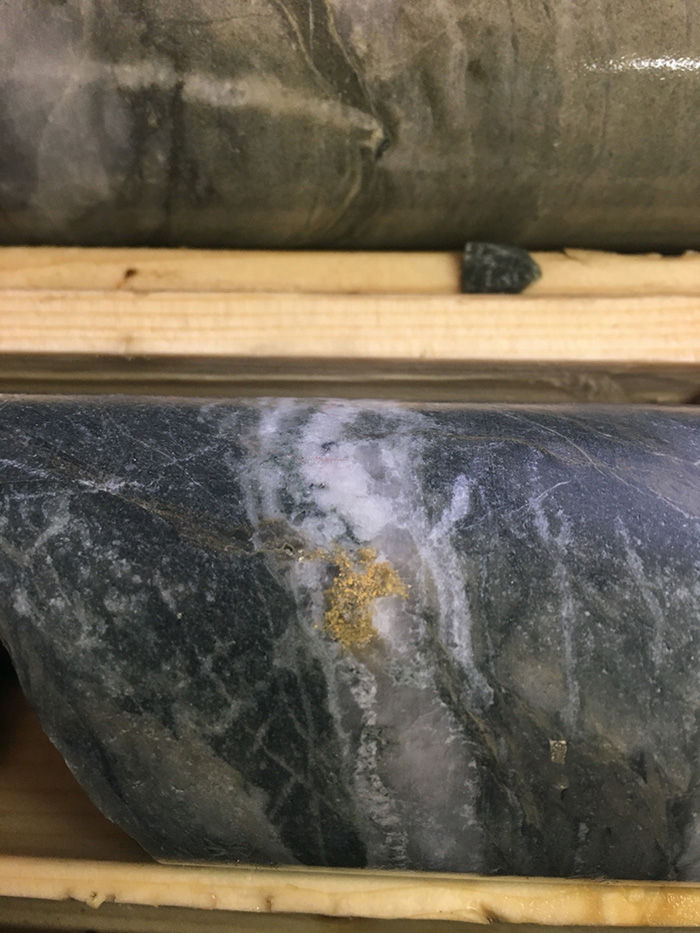
RN 20-06 Core Photo 2: Coarse Visible Gold
Qualified Person:
Todd Keast, P.Geo., a “qualified person” for the purposes of National Instrument 43-101 - Standards of Disclosure for Mineral Projects, and the Raney Gold Project Manager for Rockridge Resources Ltd., has reviewed and approved the scientific and technical disclosure in this summary.
